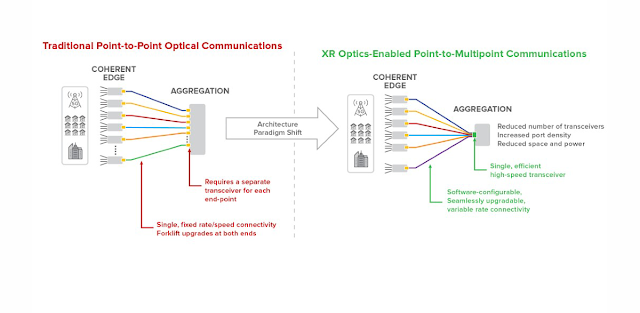Infinera announced a collaboration with II-VI, a global leader in optical communications modules, to bring to market XR optics-based networking solutions. The companies said partnership will result in the introduction of a family of easily deployable, pluggable XR optics offerings applicable across a wide variety of market applications.
Infinera said XR optics enables radically more efficient and cost-effective solutions for the transport networking challenges operators face in delivering new 5G, enhanced broadband, and cloud-based business services. Infinera's XR optics technology, which is optimized for hub-and-spoke traffic patterns, is powered by independently routable Nyquist subcarriers and coherent optical aggregation capabilities. XR optics technology enables a single high-speed transceiver to simultaneously send and receive independent data streams to/from numerous low-speed transceivers.
“We are excited to partner with II-VI to introduce this revolutionary point-to-multipoint solution that is expected to help network operators realize unprecedented savings,” said Dr. Dave Welch, Founder and Chief Innovation Officer, Infinera. “We are experiencing growing interest from our customers in XR optics, and collaborating with a leader like II-VI underscores the value of this innovation and our commitment to bring it to market with a broad-based coalition of top-tier suppliers.”
“We are looking forward to leveraging our highly integrated laser technology platform, coupled with our industry-leading optics and module expertise, together with Infinera’s coherent subcarrier aggregation DSP and transmission expertise, to achieve next-generation coherent transceiver solutions,” said Matthias Berger, Vice President, Coherent Optics Business Unit, II-VI Incorporated. “This collaboration will enable us to jointly deliver digital coherent optics in small pluggable form-factors and with low power consumption.”
In addition, Infinera announced a separate partnership with Lumentum to bring to market XR optics-based networking solutions. The partnership will result in the introduction of a family of easily deployable, pluggable XR optics offerings applicable across a wide variety of market applications.
“We are delighted to partner with Lumentum to introduce this revolutionary point-to-multipoint solution designed to help network operators benefit from unprecedented savings,” said Dr. Dave Welch, Founder and Chief Innovation Officer, Infinera. “Lumentum has been an important team player, recognizing the value of XR optics and committed to bringing this innovative solution to market.”
“Collaborating with Infinera leverages our deep experience in high-speed coherent components and pluggable modules to bring an innovative solution like XR optics to market,” said Beck Mason, Senior Vice President and General Manager of Lumentum’s Telecom Transmission Business. “The XR optics concept aligns with our core strategy to provide scalable and flexible coherent optical network solutions that enable higher speeds for next-generation transport networks.”
Infinera introduced a point-to-multipoint coherent optical subcarrier aggregation technology with the potential to significantly reduce the number of transceivers required in an access network while eliminating intermediate aggregation.
Infinera's XR optics technology, which is optimized for hub-and-spoke traffic patterns, is powered by independently routable Nyquist subcarriers and coherent optical aggregation capabilities. With coherent subcarrier aggregation (CSA) capabilities, XR optics technology enables a single high-speed transceiver to simultaneously send and receive independent data streams to/from numerous low-speed transceivers.
Subcarriers can be flexibly sized. For example, 4 X 25G subcarriers defined in a 100G QSFP-28 transcrivers; or 16 X 25G subcarriers defined in a 400G QSFP-DD transceiver.
The company says that by leveraging these capabilities, network operators will be positioned to significantly reduce the number of transceivers in the network, eliminate the need for costly intermediate aggregation devices, and more efficiently optimize transport infrastructure for hub-and-spoke end-user traffic flows.
Initial areas of focus include DAA fiber deep networks, 5G X-haul, DSL/PON backhaul, and fiber-enabled business services.
XR optics is designed to be integrated into a variety of form factors, including industry-standard pluggables, from low-speed interfaces with a single subcarrier to high-speed (400G+) interfaces with numerous subcarriers.
https://www.infinera.com/innovation/xr-optics






















